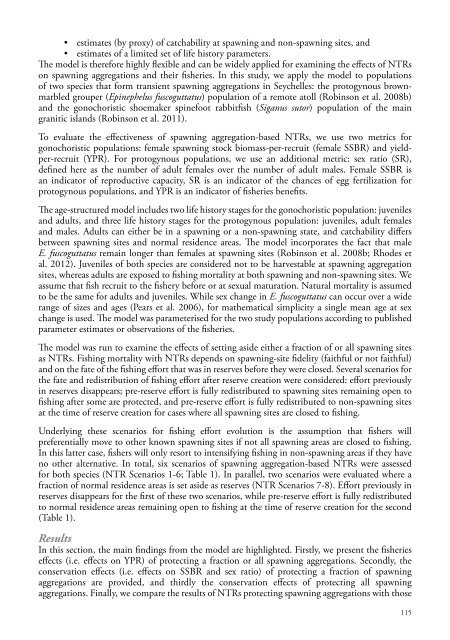WIOMSA-CORDIO spawning book Full Doc 10 oct 13.pdf
WIOMSA-CORDIO spawning book Full Doc 10 oct 13.pdf
WIOMSA-CORDIO spawning book Full Doc 10 oct 13.pdf
Create successful ePaper yourself
Turn your PDF publications into a flip-book with our unique Google optimized e-Paper software.
• estimates (by proxy) of catchability at <strong>spawning</strong> and non-<strong>spawning</strong> sites, and• estimates of a limited set of life history parameters.The model is therefore highly flexible and can be widely applied for examining the effects of NTRson <strong>spawning</strong> aggregations and their fisheries. In this study, we apply the model to populationsof two species that form transient <strong>spawning</strong> aggregations in Seychelles: the protogynous brownmarbledgrouper (Epinephelus fuscoguttatus) population of a remote atoll (Robinson et al. 2008b)and the gonochoristic shoemaker spinefoot rabbitfish (Siganus sutor) population of the maingranitic islands (Robinson et al. 2011).To evaluate the effectiveness of <strong>spawning</strong> aggregation-based NTRs, we use two metrics forgonochoristic populations: female <strong>spawning</strong> stock biomass-per-recruit (female SSBR) and yieldper-recruit(YPR). For protogynous populations, we use an additional metric: sex ratio (SR),defined here as the number of adult females over the number of adult males. Female SSBR isan indicator of reproductive capacity, SR is an indicator of the chances of egg fertilization forprotogynous populations, and YPR is an indicator of fisheries benefits.The age-structured model includes two life history stages for the gonochoristic population: juvenilesand adults, and three life history stages for the protogynous population: juveniles, adult femalesand males. Adults can either be in a <strong>spawning</strong> or a non-<strong>spawning</strong> state, and catchability differsbetween <strong>spawning</strong> sites and normal residence areas. The model incorporates the fact that maleE. fuscoguttatus remain longer than females at <strong>spawning</strong> sites (Robinson et al. 2008b; Rhodes etal. 2012). Juveniles of both species are considered not to be harvestable at <strong>spawning</strong> aggregationsites, whereas adults are exposed to fishing mortality at both <strong>spawning</strong> and non-<strong>spawning</strong> sites. Weassume that fish recruit to the fishery before or at sexual maturation. Natural mortality is assumedto be the same for adults and juveniles. While sex change in E. fuscoguttatus can occur over a widerange of sizes and ages (Pears et al. 2006), for mathematical simplicity a single mean age at sexchange is used. The model was parameterised for the two study populations according to publishedparameter estimates or observations of the fisheries.The model was run to examine the effects of setting aside either a fraction of or all <strong>spawning</strong> sitesas NTRs. Fishing mortality with NTRs depends on <strong>spawning</strong>-site fidelity (faithful or not faithful)and on the fate of the fishing effort that was in reserves before they were closed. Several scenarios forthe fate and redistribution of fishing effort after reserve creation were considered: effort previouslyin reserves disappears; pre-reserve effort is fully redistributed to <strong>spawning</strong> sites remaining open tofishing after some are protected, and pre-reserve effort is fully redistributed to non-<strong>spawning</strong> sitesat the time of reserve creation for cases where all <strong>spawning</strong> sites are closed to fishing.Underlying these scenarios for fishing effort evolution is the assumption that fishers willpreferentially move to other known <strong>spawning</strong> sites if not all <strong>spawning</strong> areas are closed to fishing.In this latter case, fishers will only resort to intensifying fishing in non-<strong>spawning</strong> areas if they haveno other alternative. In total, six scenarios of <strong>spawning</strong> aggregation-based NTRs were assessedfor both species (NTR Scenarios 1-6; Table 1). In parallel, two scenarios were evaluated where afraction of normal residence areas is set aside as reserves (NTR Scenarios 7-8). Effort previously inreserves disappears for the first of these two scenarios, while pre-reserve effort is fully redistributedto normal residence areas remaining open to fishing at the time of reserve creation for the second(Table 1).ResultsIn this section, the main findings from the model are highlighted. Firstly, we present the fisherieseffects (i.e. effects on YPR) of protecting a fraction or all <strong>spawning</strong> aggregations. Secondly, theconservation effects (i.e. effects on SSBR and sex ratio) of protecting a fraction of <strong>spawning</strong>aggregations are provided, and thirdly the conservation effects of protecting all <strong>spawning</strong>aggregations. Finally, we compare the results of NTRs protecting <strong>spawning</strong> aggregations with those115


















